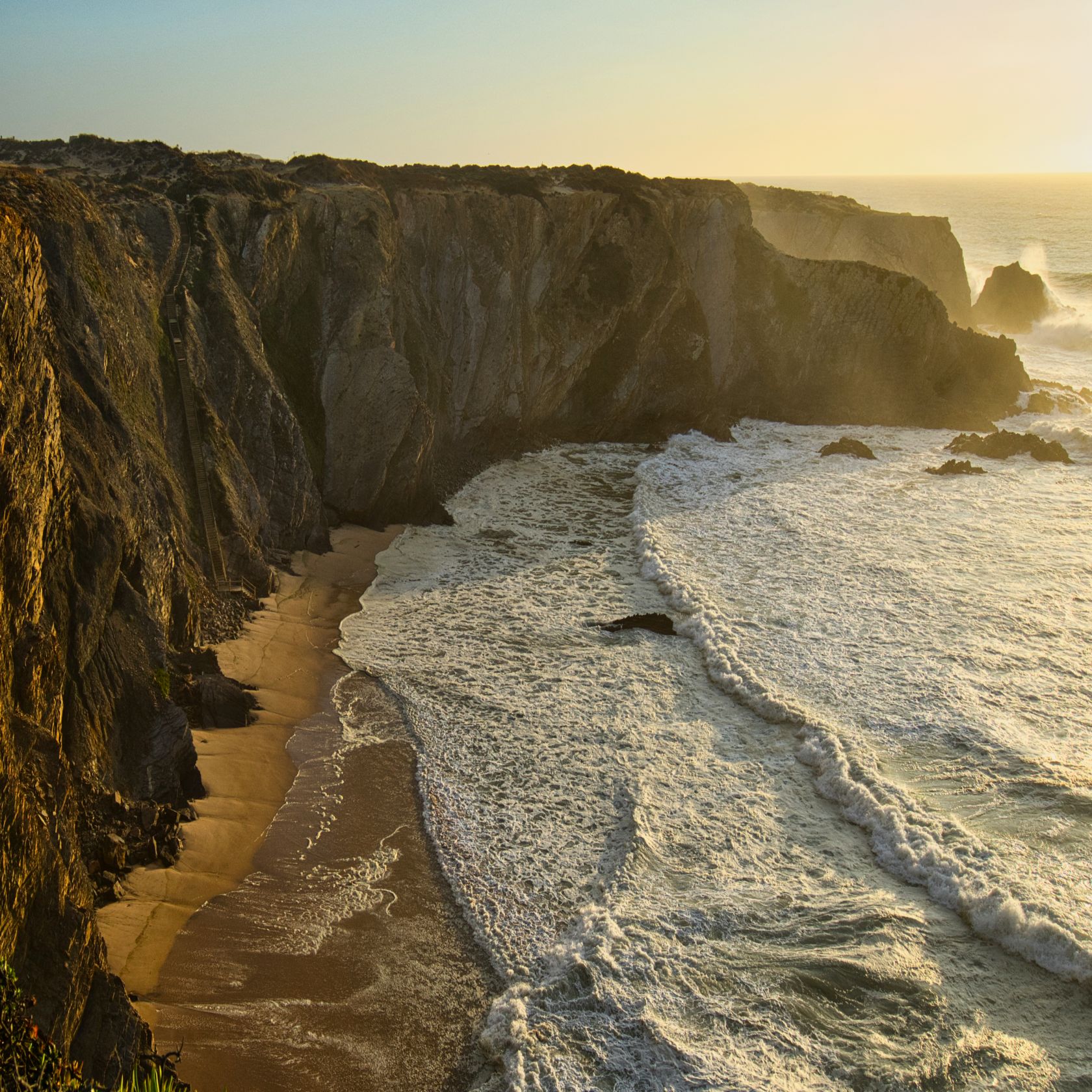From dramatic clifftops to windswept beaches, Conde Nast Travel magazine includes this hike in its 'Six Most Beautiful Coastal Treks in the World.' Peter Elia AKA themanwhohikedtheworld and his friend Stefan Hacker lace up their boots to discover why.

"I think we should stay here until
sunset," remarked Stefan as we marvelled at the panoramic views of Praia
de Odeceixe. It was only three in the afternoon, but the chance to witness
geographical wonders like this does not come around often. We had the good
fortune of witnessing a stunning fusion of elements where the bend of the River
Seixe meets both Odeceixe Beach and the Atlantic Ocean. Unlike busy sections of
the famed Camino de Santiago, the rarely-crowded Fishermen's Trail isn't a
pilgrimage route; there's no religious element to it, although the scenery at
Praia de Odeceixe, amongst others, left me uttering "Oh my God!"
The Fisherman's Trail
is a 230 km coastal stretch of the Vicentina Coast. However, due to
limited time, we chose the highlights version, from Porto Covo to Odeceixe
(around 76Km). The route is a four-day walk with stages from 15 km to 22 km
that snake across pristine beaches, up and down hill-sized dunes, along
close-to-the-edge clifftop paths, and through eucalyptus, acacia and
pine-scented forests.

The trail gets its name from the
centuries-old tracks that zigzag down from clifftops to the seemingly
inaccessible, sea-sprayed rocky outcrops that provide the best pitches from
which to cast a line. Besides
the odd villager or fisherman, no one used to walk these cliffs at the
continent's edge. It is remote, wild, and relatively unexplored – the official
hiking trail was established in 2013.
The best times to hike here are spring,
when wildflowers are in fragrant bloom, and autumn. It's best to avoid July and
August when the temperature hits 30 °C plus. We chose to come in February for a
winter escape from London to Lisbon. It's just two hours by bus from the
capital to Porto Covo, and we started our trip by heading down the coast. Those
coming from the Algarve can hike the Fisherman's Trail in the opposite
direction from Odeceixe; (one hour by bus from Lagos). However, the route
reveals increasingly spectacular scenery when hiking North to South.
Trail Highlights
Porto Covo is a
jumble of whitewashed cottages and quiet cobbled streets, and a far cry from
bustling Lisbon. It’s best described as a former fishing village now
opening its arms to tourism. We headed to our first guesthouse where we met
Ricardo from Vicentina Travel for our briefing. Over a cold beer, Ricardo gave us all
the information for our self-guided hike, including main attractions to look
out for, restaurant recommendations and a route map. However, you can't really
go wrong with navigation, just keep the mainland on your left and the Atlantic
Ocean to the right. If Stefan and I had got that wrong, we'd never have hiked
again!

To make our lives even easier, we opted to
have our luggage collected every morning and delivered to the next guest house.
This allowed us to carry only a small backpack containing our waterproofs,
camera, water and a packed lunch.
Porto Covo to Vila Nova de Milfontes (20
km) is the beaches and dunes stage, and perhaps the most challenging, but worth it for the views.
There were common themes dominating our four days of walking, like regularly-spaced
signs that warn: "Beware! Crumbling cliff." And unless you have a
parachute, do not ignore them. The golden rule is always to stay alive. Keeping
a few metres from the cliff edges will ensure an exhilarating but safe hike.
On day two, we left Vila Nova, which sits
on the north bank of the Mira where it flows into the ocean. The journey to
Almograve is 15 km and took five hours, or 12 km if the little cross-river
ferry is running. We spent the morning swimming in the bracing Atlantic,
followed by a leisurely bike ride around town. In the early afternoon, we set
off for the shortest stage, making for a relaxing half-day along beaches and
clifftops.

At 22 km, Almograve to Zambujeira do Mar
is the longest stage with fewer beaches and more clifftops, but the seven hours
will fly by in no time. The landscape here reveals millions of years of seismic activity, volcanic eruptions, and tidal
erosion that sculpted this coast. In this unique part of the world, storks
build huge nests the size of tables on top of towering sea stacks. In addition,
solitary anglers stand in hazardous spots,
appearing to risk being washed away while reeling in local favourites like
bream, bass and dory. It's sights like this which give the Fisherman’s trail
its natural charm.

Finally, Zambujeira
to Odeceixe (18 km) is our last leg and the most rewarding. The spectacular
view from the Ponta Branca headland of Odeceixe beach was the perfect way to end
our hike. Stefan’s and my only dilemma now was choosing a bar in Odeceixe to have
our celebratory cold beers.

Why go?
Hiking
the four-day Fisherman's Trail was perfect for us because it ticked all our
boxes. Its daily sections are not too long nor too short. It runs through a
remote natural area and connects villages that offer the beneficial comfort of
hot showers, warm meals, and good beds to rest weary bodies at night.
Above all, the Fisherman’s Trail is such good fun, and
this stems from its authenticity within a stunning environment. Portugal is
blessed to have a region which offers a slice of real, local life in one of
Europe's last undeveloped
and preserved coastlines. Long may it continue!
For
more information and how to book the Fisherman’s Trail please visit:













